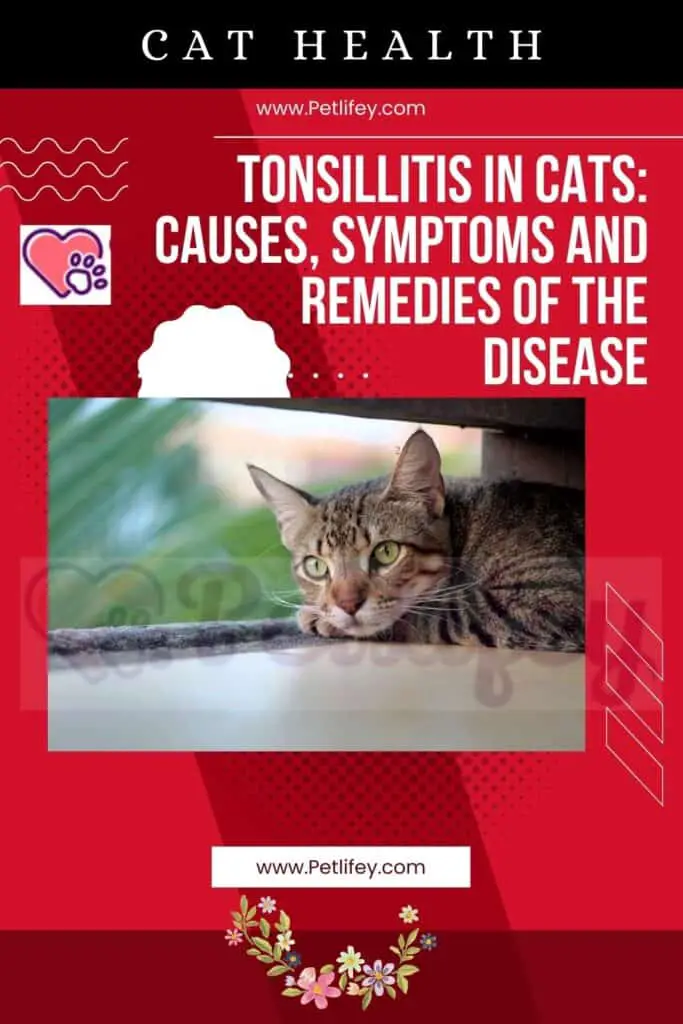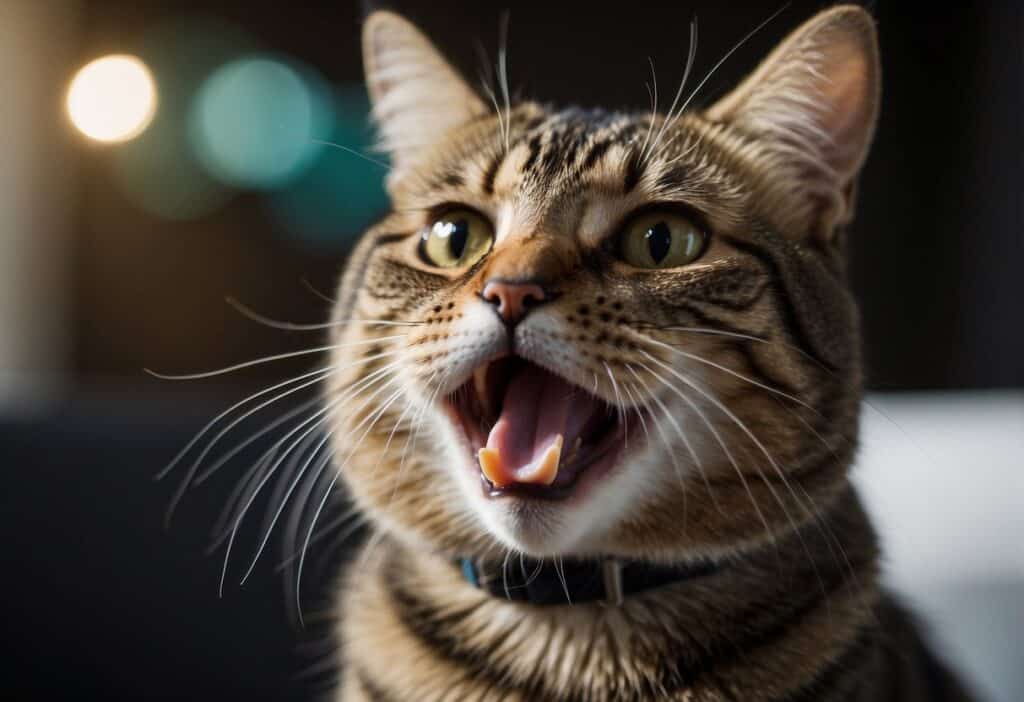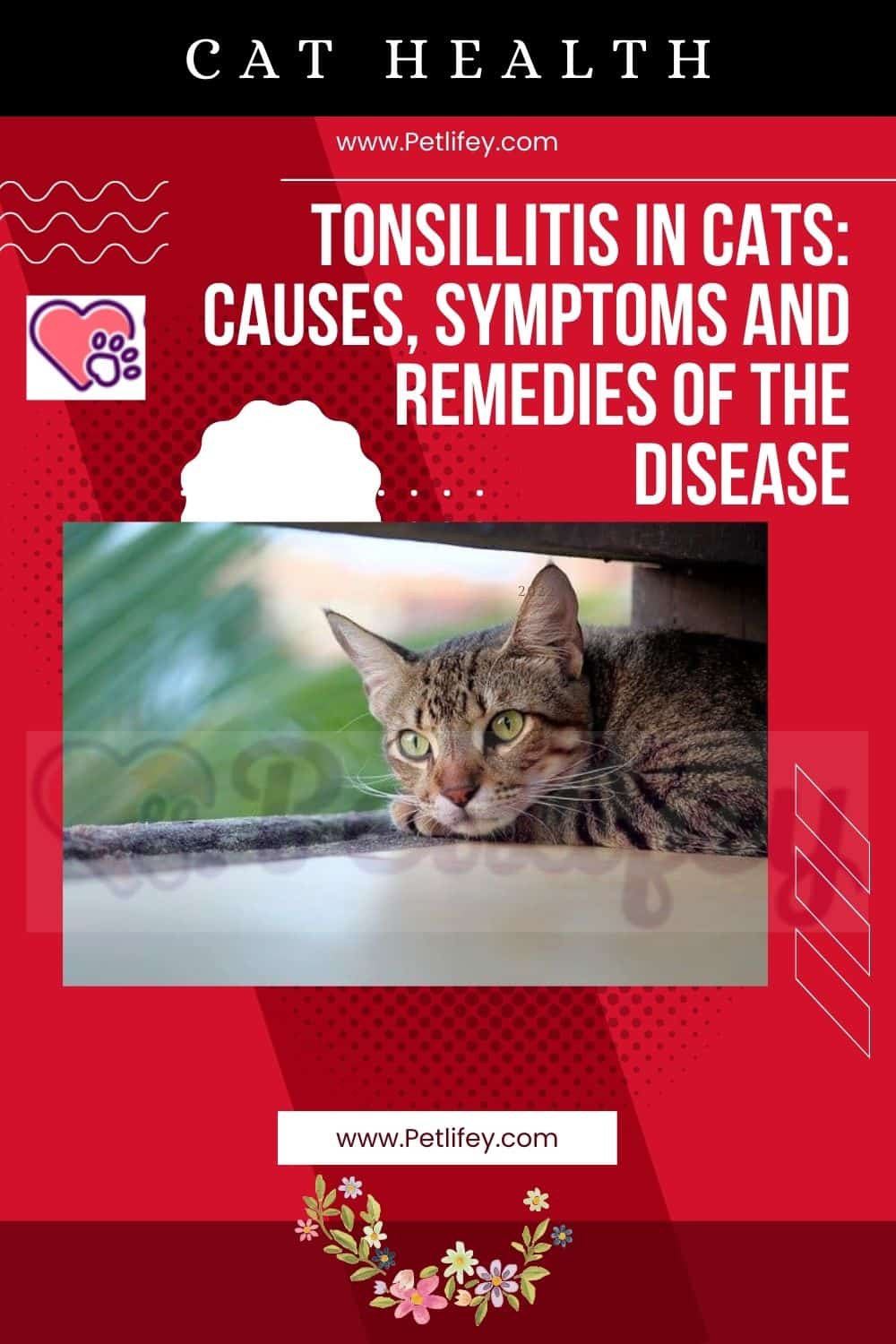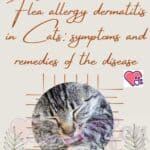Tonsillitis in Cats: Comprehensive Guide to Causes, Symptoms, and Treatments

Tonsillitis in cats is an inflammatory condition primarily affecting the palatine tonsils, which serve as part of the immune system’s first line of defense. Your cat’s tonsils are situated at the back of the throat and play a crucial role in filtering out pathogens that may enter through the nose and mouth. Inflammation of these tonsils can be due to several reasons but is most commonly a result of bacterial or viral infections. Recognizing that your feline may be suffering from this disease involves being aware of its presentation and possible underlying causes.
Symptoms of tonsillitis in cats can vary but often include difficulty swallowing, excessive drooling, reduced appetite, and potential fever if a bacterial infection is present. Since tonsillitis in felines can be a secondary condition, it’s important for you to observe if these symptoms are accompanied by signs indicative of other health issues, such as respiratory infections or digestive disturbances. Understanding these symptoms enables you to seek timely veterinary care, which is crucial in managing the condition effectively.
When you bring your cat to the vet, they may recommend a range of treatments depending on the severity and underlying cause of the tonsillitis. If a bacterial infection is diagnosed, antibiotics will likely be part of the treatment plan. In cases where a viral infection is the culprit, supportive care to manage symptoms will be central to your cat’s recovery. Always ensure that your pet has access to plenty of fresh water, and monitor their condition closely, following the vet’s advice on how to support their immune system during this time.
Understanding Tonsillitis in Cats

In this section, you’ll find information focused on the nature of tonsillitis in cats, its common causes, and the way it impacts the health of your feline friend.
Definition and Overview
Tonsillitis is an inflammatory condition of the tonsils, which are part of the immune system’s first line of defense located at the throat’s back. In cats, this is a rare but significant condition since the tonsils participate in protecting your cat’s body by trapping incoming pathogens through the mouth and throat.
Common Causes of Tonsillitis
Tonsillitis in cats can stem from a variety of causes:
- Bacterial Infections: Conditions such as streptococcus or E. coli are often to blame.
- Viral Infections: Other times, viruses like feline calicivirus or feline herpesvirus may be the culprits.
- Upper Respiratory Infections: More broadly, upper respiratory infections can lead to the development of tonsillitis.
- Compromised Immunity: Cats with weakened immune systems, possibly due to conditions like feline immunodeficiency virus (FIV) or feline leukemia, are at higher risk.
How Tonsillitis Affects Feline Health
When your cat suffers from tonsillitis, several health issues may arise:
- Inflammation: This is the primary symptom, which can contribute to swelling, redness, and pain in the throat area.
- Dysphagia: Difficulty swallowing is a common sign that your cat’s inflamed tonsils are causing distress.
- Discomfort: As the tonsils are lymphoid tissue and part of the immune system, inflammation here can cause overall discomfort and may lead to lethargy or decreased activity.
Identifying Tonsillitis
When your cat exhibits changes in behavior or health, identifying the cause is crucial. Tonsillitis may be underlying when symptoms such as sore throat and difficulty swallowing arise. Awareness of symptoms and diagnostic procedures can facilitate prompt care.
Notable Symptoms
Your cat may not be able to communicate discomfort, but certain behaviors are indicative of tonsillitis. Watch for these symptoms:
- Decreased appetite: A reluctance to eat, which may be due to pain or difficulty swallowing.
- Vomiting and coughing: These can be signs that the tonsils are irritated or inflamed.
- Drooling: Excessive salivation could suggest a sore throat or inability to swallow.
- Breathing difficulty: In severe cases, inflamed tonsils can obstruct breathing.
- Fever: A higher than normal body temperature may indicate a bacterial infection.
Diagnosis Procedures
If you observe any of the above symptoms, a visit to your veterinarian is warranted. Here’s how a diagnosis is typically made:
- Physical Examination: The veterinarian will perform a thorough physical examination, which may include palpating the throat area for swelling or pain.
- Throat Swab: A sample from the throat may be taken to determine the presence of bacteria or viruses causing the infection.
- X-rays or Blood Tests: In some cases, further diagnostic tools like x-rays or blood tests may be used to rule out other conditions.
- Culture: To identify the specific type of bacteria or virus, a culture of the tonsil tissue may be necessary.
This organized approach helps your veterinarian accurately diagnose tonsillitis and differentiate it from other potential issues with similar symptoms.
Treatment Options and Management
Successful treatment of tonsillitis in cats hinges on accurate diagnosis and prompt action to address the root cause and alleviate symptoms.
Immediate Treatments
If your cat is diagnosed with tonsillitis, immediate treatment typically involves antibiotics to combat any underlying bacterial infection. In cases where a viral culprit is identified, antiviral medications may be prescribed. It’s imperative to initiate these medications under veterinary guidance to ensure proper use and dosage.
Surgical Interventions
Surgical intervention, such as a tonsillectomy (removal of the tonsils), is considered when tonsillitis is chronic or if there is formation of an abscess or concerning lesions. While surgery is not commonly needed, it is a decisive option if conservative treatments fail.
Supportive Care
Supportive care plays a vital role in managing tonsillitis in cats. Essentials include:
- Administering pain medication to ensure comfort.
- Providing fluids to maintain hydration, which can be oral or intravenous, especially if your cat has difficulty swallowing.
- Offering nutritional support through easily-swallowable foods or, in severe cases, through temporary feeding tubes.
Monitoring and Recovery
Post-treatment, monitoring and follow-up visits are crucial to assess recovery and prevent recurrence. Keep a close watch on your cat’s behavior and appetite, as these are good indicators of their recovery progress. Your vet may schedule additional visits to monitor the healing of any surgical sites and ensure that your cat is on the right track to full health.
Complications and Related Conditions
Tonsillitis in cats can lead to specific complications and may coexist with other health issues that require attention. Understanding these risks enables you to seek timely veterinary care for your cat.
Potential Complications
When your cat suffers from tonsillitis, the inflammation of the tonsils can seriously affect their well-being. One major complication includes difficulty swallowing due to the swollen tissues, which can potentially lead to dehydration or malnutrition if not addressed.
- Breathing difficulty: The swelling associated with tonsillitis can impede normal breathing, leading to stress and further complications.
Moreover, without proper treatment, the inflammation might result in persistent irritation of the throat, creating an environment in which growth of additional bacteria and formation of pus could exacerbate the condition.
Concurrent Health Issues
Tonsillitis in cats is often seen in conjunction with other health problems. Commonly associated conditions include:
- Oral diseases: These can range from dental abscesses to periodontal disease and might be the initial cause of tonsillar inflammation.
- Upper airway infections: Respiratory infections, such as those caused by feline calicivirus, can involve the tonsils and lead to tonsillitis.
- Foreign objects: Items lodged in the throat or pharynx can cause irritation and inflammation, leading to tonsillitis.
- Pharyngitis: Inflammation of the pharynx often occurs together with tonsillitis, as both are part of the upper airway.
- Tumors or abnormal growths: Though less common, these can also cause inflammation and symptoms similar to tonsillitis.
Recognizing these related conditions is crucial in managing your cat’s tonsillitis and averting further health complications. If you notice symptoms such as difficulties with eating, persistent coughing, or breathlessness, consult your vet promptly to rule out or address underlying conditions.
Preventative Measures
Tonsillitis in cats can often be a secondary condition, making prevention a two-fold strategy: minimizing exposure to causative factors and enhancing your cat’s immune defenses.
Minimizing Risk Factors
To reduce the risk of bacterial and viral infections that can lead to tonsillitis, pay close attention to your cat’s living conditions. Ensure that their food and water bowls are cleaned regularly to prevent the growth and spread of bacteria. Similarly, maintaining clean litter boxes is crucial to prevent exposure to infectious agents.
- Grooming: Regular grooming helps remove debris that could cause irritation or infection.
- Indoor Environment: Keeping your cat indoors can reduce exposure to pathogens and decrease stress, which can weaken the immune system.
- Stress: Implement routines that promote a calm environment, as stress can negatively impact health.
Boosting Feline Immunity
Strengthening your cat’s immune system is vital for preventing tonsillitis and other infections. Consider these steps to boost immunity:
- Vaccination: Stay up-to-date with vaccinations to protect against common viral infections.
- Diet: Provide a balanced diet rich in nutrients that support immune health.
- Wellness Checks: Regular veterinary check-ups can help identify and address any underlying health issues before they weaken the immune system further.
By implementing these strategies, you can help shield your cat from the risks associated with tonsillitis.
When to Seek Professional Help
If your cat exhibits signs of tonsillitis such as persistent coughing or gagging, it’s important to monitor them closely. Look out for symptoms like:
- Excessive drooling
- Difficulty swallowing
- Reluctance to eat
These could indicate that your cat’s condition might be more than just a minor throat irritation.
Should you notice a combination of these symptoms with lethargy or a noticeable decrease in energy levels, this is a strong signal to consult your veterinarian. Lethargy can be a sign of a more serious underlying condition requiring professional attention.
Pay attention to their behavior, as cats in pain might become more withdrawn or show aggression when touched. If you suspect your cat is in pain and you’re considering over-the-counter pain relievers, it’s vital to remember that many medications safe for humans can be harmful to cats. Therefore, always seek veterinary advice before administering any form of medication.
Here is a simple checklist to help you decide when professional help is needed:
| Symptom | Action Required |
|---|---|
| Persistent coughing or gagging | Observe and consult veterinarian if it persists |
| Difficulty swallowing or excessive drool | Schedule a veterinarian visit |
| Reluctance to eat | Consult with your veterinarian promptly |
| Signs of pain (e.g., withdrawal, aggression) | Contact your veterinarian immediately |
| Lethargy or change in behavior | Seek veterinary advice as soon as possible |
Tonsillitis can be a sign of a secondary infection or another health issue; thus, a timely visit to the veterinarian is crucial to ensuring your cat receives the appropriate treatment and recovers without complications.
Conclusion
Tonsillitis in cats, while not exceedingly common, requires your attention for prompt management. As a cat owner, your vigilance plays a crucial role in detecting early symptoms. Notice signs such as reluctance to eat, bad breath, or abnormal sounds when your pet is breathing. These could indicate inflammation of the tonsils.
Your proactive approach to health maintenance can mitigate potential complications. Ensure regular veterinarian visits for health checkups, including oral assessments. In the case of tonsillitis, treatment will likely involve antibiotics to address a bacterial cause, and possibly anti-inflammatory medications to reduce swelling and discomfort.
Remember:
- Early detection and treatment are vital.
- Regular veterinarian consultations contribute to overall health.
- Owner vigilance helps catch symptoms that might easily be overlooked.
Tonsillitis can be the manifestation of an underlying condition. Therefore, a comprehensive examination by your veterinarian is essential to address not just the symptoms, but also the root cause. By maintaining a watchful eye and a commitment to your cat’s health, you can ensure a swift response to issues like tonsillitis, thereby providing a loving and caring environment for your feline companion.







